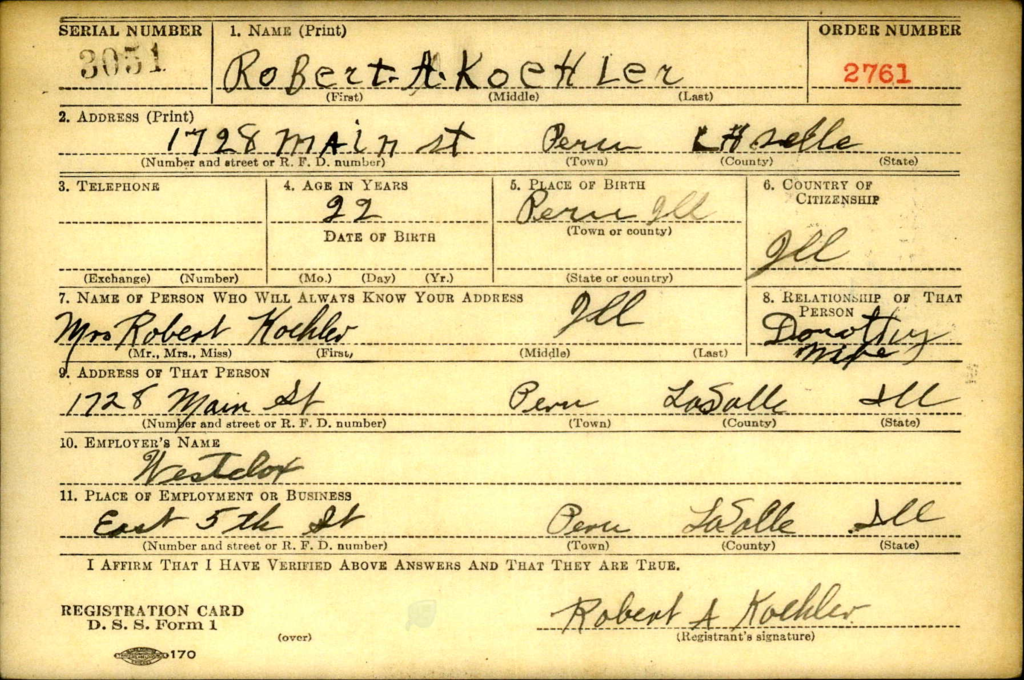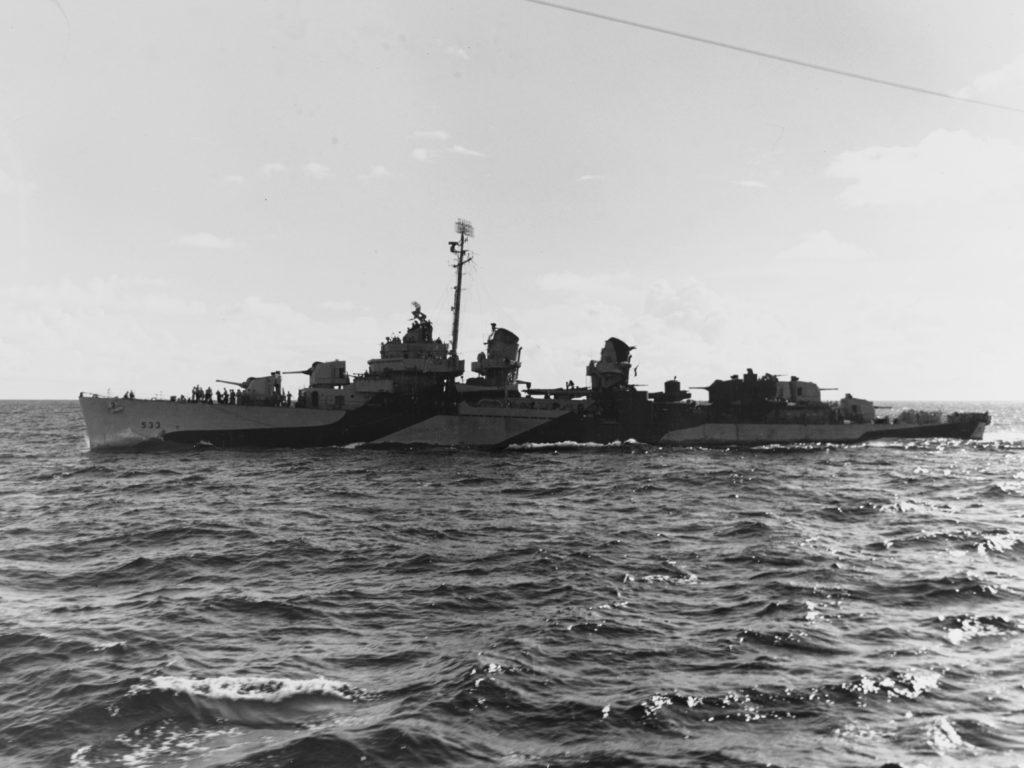Robert August Koehler was born on 28 September 1918, in Peru, Illinois, as both war and a flu pandemic were raging across the world. While the war would cease a month and a half after his birth, the pandemic would go on for another year. In the midst of this turmoil, Robert’s parents, August and Elsie Elizabeth (Pyka) Koehler, were raising Robert and his two older sisters Mildred and Gladys in a home they owned at 2315 Main street in southwest Peru. August Koehler was supporting his family by working as a buffer at Westclox—a local clock factory. Two years after Robert was born, August and Elsie had another son they named Clyde.
By 1928, August and Elsie were living in a different home at 1904 State street in Peru, just a few blocks east of their old home. August had left the clock factory and was operating a soft drink parlor at 1715 Water street along the Illinois River in Peru. A few years later on 10 July 1930, when Robert was 11, his mother died; she was 39 years old. His father August married again the next year taking Esther Miller of Peru as his bride. Two children soon followed, both sons.
Robert decided to leave school after the eighth grade like so many others during this time period. Once he became an adult he began working for Westclox. While there he may have met Dorothy Noll who he married in Clinton, Iowa, on 2 September 1939. His marriage license said he was 22 and Dorothy was 20, but based on other records he may have been a few weeks shy of 21.
The next year on 16 October 1940, Robert registered for the draft in Peru. His draft card showed his age as 22 and his height and weight as 5 feet 10 inches and 147 pounds. He had brown hair and eyes. Two years later his younger brother Clyde, who was working at the Star Union Products Company, registered for the draft on 16 February 1942. Later that year on 25 September 1942, Clyde enlisted in the U.S. Army in Chicago.

Three and a half more years after registering, Robert enlisted in the U.S. Navy on 5 May 1944, in Chicago. On 14 August 1944, three months after he enlisted, Seaman Robert Koehler was in California making his way onto the USS Hoel (DD-533). He was shown on the ship’s muster roll that day as a US Navy Reserve Selective Volunteer. After picking up the group of new sailors, the USS Hoel began making its way to the South Pacific to support the mission to free the Philippines.
This undertaking had been greenlighted by President Roosevelt about a week before the USS Hoel sailed. An alternate plan was proposed by Admiral Nimitz to instead secure Taiwan. But General Douglas MacArthur’s impassioned plea to focus instead on the Philippines convinced the President to back his plan. In doing so, the President assigned the Third and Seventh Fleets under Admiral Nimitz to support the mission.
By 20 October 1944, McArthur was wading to the shores of Leyte to announce his return. Supporting the Army, as directed to do so by the President, the Navy was positioned out in the Leyte Gulf with the Third Fleet under Admiral Halsey to the north and the Seventh Fleet under Vice Admiral Kinkaid to the south. The USS Hoel was assigned to the Seventh Fleet as part of the northwesterly most task unit referred to as “Taffy 3” under the command of Rear Admiral Clifton Sprague. But unknown to the U.S. forces, the Japanese Empire was not planning to give up the Philippines that easily. Instead they devised a plan they named Sho Go to ensure their victory over the United States.
The Japanese plan relied on launching two separate concentrations of forces led by Vice Admiral Kurita. The smaller force under Vice Admiral Nishimura’s command was directed to travel south through the Sulu and Mindanao Seas and then through the Suriagao Strait entering the Leyte Gulf south of the US forces.
Meanwhile Kurita’s larger force would travel to the north under his direct command through the Sibuyan Sea and San Bernardino Strait along Samar. This route would take his fleet of four battleships, six heavy cruisers, 11 destroyers, and two light cruisers to the north of the US forces.
Another key component of the Sho Go plan was to send a decoy fleet of carriers under Admiral Ozawa even further north. This was a crucial component of the plan because it relied on the idea that the lure of engaging Japanese carriers would be too great of an opportunity for Admiral Halsey to ignore.
As Kurita’s fleet sailed north, on 24 October 1944, it entered an area within striking distance of Halsey’s aircraft. Over the course of the day the Japanese fleet took hits from the bombers resulting in the ultimate sinking of the super battleship Musashi. While Kurita lost a few ships, by the end of the engagement he was able to continue on across the Sibuyan Sea towards the Leyte Gulf.
Further to the south as darkness descended, Rear Admiral Oldendorf under the command of Kinkaid moved to engage Nishimura’s fleet. Between torpedoes launched by. U.S. destroyers and shooting from the cruisers and battleships, Nishimura’s forces were neutralized. The United States lost 39 men; 114 were wounded.
Stationed between both Halsey and Oldendorf’s fleets was task unit Taffy 3. This fleet of ships included three Destroyers—Hoel, Heermann, and Johnston, six escort carriers, and four destroyer escorts. With Halsey to the north and Oldendorf to the south, this group did not expect to experience the same type of engagement the other fleets endured. However, Ozawa had made his move on the 24th, and upon hearing Japanese carriers were nearby, Halsey took the bait pulling his entire fleet including battleships to join him in his pursuit of this decoy.
With Halsey’s fleet out of the way, Kurita was able on the 25th to enter the Philippine Sea and sail towards Taffy 3’s position with no opposition. Taffy 3 began to hear reports of their movement early on the 25th from a pilot who had been flying lookout. While fewer in number and significantly outclassed, Taffy 3 engaged the Japanese fleet with all they had. The fight they presented was so intense, Kurita was convinced he was fighting a much larger fleet, possibly Halsey’s Third Fleet. As the U.S. carriers launched all their planes and then maneuvered to avoid the battle, the destroyers and other ships took turns launching their torpedoes and shooting the much larger Japanese ships. The pilots supporting from the air dropped what bombs they could then shifted to dive bombing the ships and shooting with their machine guns.

The resulting battle is described on the U.S. Naval Institute site as “one of the wildest melees in naval history, marked by errors of judgement, innovative tactics, terrible carnage, and selfless valor.” Because of the “sacrificial actions and the confusion that resulted among the Japanese forces the day was saved.” However, many were lost in the fight. Before Kurita decided he better turn around rather than press his advantage, he managed to sink two destroyers: Hoel and Johnston, one destroyer escort: Samuel B. Roberts, and one escort carrier: the Gambier Bay. A kamikaze pilot would later take out the St. Lo.
The men who made it through the battle and were still alive had to next endure anywhere from 18 to 48 hours in the sea until other ships could rescue the roughly 1,150 survivors. Below is the total number of fallen and surviving from each ship. These numbers include those who died in the battle and those who perished waiting to be rescued:
- USS Samuel B. Roberts (DE-413): 90 perished; 120 survived
- Hoel (DD-533): 252 perished; 86 survived
- Johnston (DD-557): 186 perished; 141 survived
- Gambier Bay (CVE-73): about 128 perished; 706 survived
- USS St. Lo (CVE-63): about 143 perished; about 746 survived
It’s not known if Seaman Robert Koehler perished on his ship during the battle or later waiting to be rescued from the sea. He is remembered on the Tablets of the Missing in the Manila American Cemetery and Memorial.
According to the Navy website, the USS “Hoel earned the Presidential Unit Citation for her efforts to deter and destroy the enemy forces.” More than 70 years later, efforts were made by several companies to locate the ships involved in this battle. They succeeded in finding and identifying the USS St. Lo, the USS Johnston, and the USS Samuel B. Roberts. The USS Samuel B. Roberts is the deepest shipwreck ever recorded at more than 22,600 feet.

This story is part of the Stories Behind the Stars project (see www.storiesbehindthestars.org). This is a national effort of volunteers to write the stories of all 421,000+ of the US WWII fallen saved on Together We Served and Fold3. Can you help write these stories? These stories will be accessible via smartphone app at any war memorial or cemetery.
If you noticed anything erroneous in this profile or have additional information to contribute to it, please email feedback@storiesbehindthestars.org.
- SBTSProject/Illinois/LaSalle
- SBTS Historian Pam Broviak
You can also access this story at the following sites:
Source List:
- 1920 U.S. census, Ancestry.
- 1930 U.S. census, Ancestry.
- 1940 U.S. census, Ancestry.
- U.S., City Directories, 1822-1995, LaSalle, 1928, August Koehler, Ancestry.
- U.S., City Directories, 1822-1995, LaSalle, 1932, August Koehler, Ancestry.
- U.S., City Directories, 1822-1995, LaSalle, 1935, Robt Koehler, Ancestry.
- U.S., City Directories, 1822-1995, LaSalle, 1937, Robt Koehler, Ancestry.
- U.S., City Directories, 1822-1995, LaSalle, 1938, Dorothy Noll, Ancestry.
- Iowa, U.S., Marriage Records, 1880-1945, Robert Koehler and Dorothy Noll, 1939, Vol. 2 Chickasaw county thru Des Moines county, Ancestry.
- U.S., World War II Draft Cards Young Men, 1940-1947, Robert A. Koehler, Ancestry.
- U.S., World War II Draft Cards Young Men, 1940-1947, Clyde John Koehler, Ancestry.
- U.S., Social Security Death Index, 1935-2014, Robert A Koehler, Ancestry.
- Illinois, U.S., Deaths and Stillbirths Index, 1916-1947, Elsie Elizabeth Koehler, Ancestry.
- “Marriage Licenses for Henry County,” 21 March 1931, p. 12, Newspapers.com.
- Influenza Milestones 1917 – 2009 Timeline, CDC.
- U.S., Department of Veterans Affairs BIRLS Death File, 1850-2010, Robert A. Koehler, Ancestry.
- U.S., World War II Navy Muster Rolls, 1938-1949, Robert August Koehler, No. 11, 14 August 1944, Hoel, Ancestry.
- Pacific Strategy Conference, World War II Database website.
- James D. Hornfischer, The Last Stand of the Tin Can Sailors, New York: Random House Publishing Group, 2004.
- USS St. Lo, Wikipedia.
- https://www.nbcnews.com/news/world/uss-samuel-b-roberts-deepest-shipwreck-discovered-philippines-rcna35455.
- John Grady, USS Samuel B. Roberts, Sunk in Battle of Leyte Gulf, Found, US Naval Institute.
- Midshipman 1/C Swanson, USN, GIS Analysis of the Battle off Samar, October 1944.
- The Battle off Samar: The Sacrifice of “Taffy 3,” Naval History and Heritage Command website.
- https://www.findagrave.com/memorial/56770713/robert-august-koehler